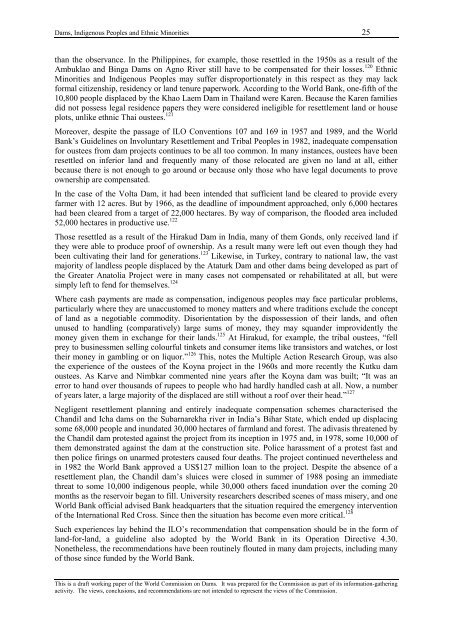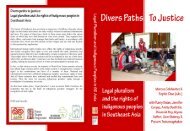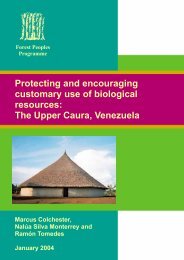Thematic Review II.2: Dams, Indigenous Peoples and Ethnic Minorities
Thematic Review II.2: Dams, Indigenous Peoples and Ethnic Minorities
Thematic Review II.2: Dams, Indigenous Peoples and Ethnic Minorities
You also want an ePaper? Increase the reach of your titles
YUMPU automatically turns print PDFs into web optimized ePapers that Google loves.
<strong>Dams</strong>, <strong>Indigenous</strong> <strong>Peoples</strong> <strong>and</strong> <strong>Ethnic</strong> <strong>Minorities</strong> 25<br />
than the observance. In the Philippines, for example, those resettled in the 1950s as a result of the<br />
Ambuklao <strong>and</strong> Binga <strong>Dams</strong> on Agno River still have to be compensated for their losses. 120 <strong>Ethnic</strong><br />
<strong>Minorities</strong> <strong>and</strong> <strong>Indigenous</strong> <strong>Peoples</strong> may suffer disproportionately in this respect as they may lack<br />
formal citizenship, residency or l<strong>and</strong> tenure paperwork. According to the World Bank, one-fifth of the<br />
10,800 people displaced by the Khao Laem Dam in Thail<strong>and</strong> were Karen. Because the Karen families<br />
did not possess legal residence papers they were considered ineligible for resettlement l<strong>and</strong> or house<br />
plots, unlike ethnic Thai oustees. 121<br />
Moreover, despite the passage of ILO Conventions 107 <strong>and</strong> 169 in 1957 <strong>and</strong> 1989, <strong>and</strong> the World<br />
Bank’s Guidelines on Involuntary Resettlement <strong>and</strong> Tribal <strong>Peoples</strong> in 1982, inadequate compensation<br />
for oustees from dam projects continues to be all too common. In many instances, oustees have been<br />
resettled on inferior l<strong>and</strong> <strong>and</strong> frequently many of those relocated are given no l<strong>and</strong> at all, either<br />
because there is not enough to go around or because only those who have legal documents to prove<br />
ownership are compensated.<br />
In the case of the Volta Dam, it had been intended that sufficient l<strong>and</strong> be cleared to provide every<br />
farmer with 12 acres. But by 1966, as the deadline of impoundment approached, only 6,000 hectares<br />
had been cleared from a target of 22,000 hectares. By way of comparison, the flooded area included<br />
52,000 hectares in productive use. 122<br />
Those resettled as a result of the Hirakud Dam in India, many of them Gonds, only received l<strong>and</strong> if<br />
they were able to produce proof of ownership. As a result many were left out even though they had<br />
been cultivating their l<strong>and</strong> for generations. 123 Likewise, in Turkey, contrary to national law, the vast<br />
majority of l<strong>and</strong>less people displaced by the Ataturk Dam <strong>and</strong> other dams being developed as part of<br />
the Greater Anatolia Project were in many cases not compensated or rehabilitated at all, but were<br />
simply left to fend for themselves. 124<br />
Where cash payments are made as compensation, indigenous peoples may face particular problems,<br />
particularly where they are unaccustomed to money matters <strong>and</strong> where traditions exclude the concept<br />
of l<strong>and</strong> as a negotiable commodity. Disorientation by the dispossession of their l<strong>and</strong>s, <strong>and</strong> often<br />
unused to h<strong>and</strong>ling (comparatively) large sums of money, they may squ<strong>and</strong>er improvidently the<br />
money given them in exchange for their l<strong>and</strong>s. 125 At Hirakud, for example, the tribal oustees, “fell<br />
prey to businessmen selling colourful tinkets <strong>and</strong> consumer items like transistors <strong>and</strong> watches, or lost<br />
their money in gambling or on liquor.” 126 This, notes the Multiple Action Research Group, was also<br />
the experience of the oustees of the Koyna project in the 1960s <strong>and</strong> more recently the Kutku dam<br />
oustees. As Karve <strong>and</strong> Nimbkar commented nine years after the Koyna dam was built; “It was an<br />
error to h<strong>and</strong> over thous<strong>and</strong>s of rupees to people who had hardly h<strong>and</strong>led cash at all. Now, a number<br />
of years later, a large majority of the displaced are still without a roof over their head.” 127<br />
Negligent resettlement planning <strong>and</strong> entirely inadequate compensation schemes characterised the<br />
Ch<strong>and</strong>il <strong>and</strong> Icha dams on the Subarnarekha river in India’s Bihar State, which ended up displacing<br />
some 68,000 people <strong>and</strong> inundated 30,000 hectares of farml<strong>and</strong> <strong>and</strong> forest. The adivasis threatened by<br />
the Ch<strong>and</strong>il dam protested against the project from its inception in 1975 <strong>and</strong>, in 1978, some 10,000 of<br />
them demonstrated against the dam at the construction site. Police harassment of a protest fast <strong>and</strong><br />
then police firings on unarmed protesters caused four deaths. The project continued nevertheless <strong>and</strong><br />
in 1982 the World Bank approved a US$127 million loan to the project. Despite the absence of a<br />
resettlement plan, the Ch<strong>and</strong>il dam’s sluices were closed in summer of 1988 posing an immediate<br />
threat to some 10,000 indigenous people, while 30,000 others faced inundation over the coming 20<br />
months as the reservoir began to fill. University researchers described scenes of mass misery, <strong>and</strong> one<br />
World Bank official advised Bank headquarters that the situation required the emergency intervention<br />
of the International Red Cross. Since then the situation has become even more critical. 128<br />
Such experiences lay behind the ILO’s recommendation that compensation should be in the form of<br />
l<strong>and</strong>-for-l<strong>and</strong>, a guideline also adopted by the World Bank in its Operation Directive 4.30.<br />
Nonetheless, the recommendations have been routinely flouted in many dam projects, including many<br />
of those since funded by the World Bank.<br />
This is a draft working paper of the World Commission on <strong>Dams</strong>. It was prepared for the Commission as part of its information-gathering<br />
activity. The views, conclusions, <strong>and</strong> recommendations are not intended to represent the views of the Commission.

















